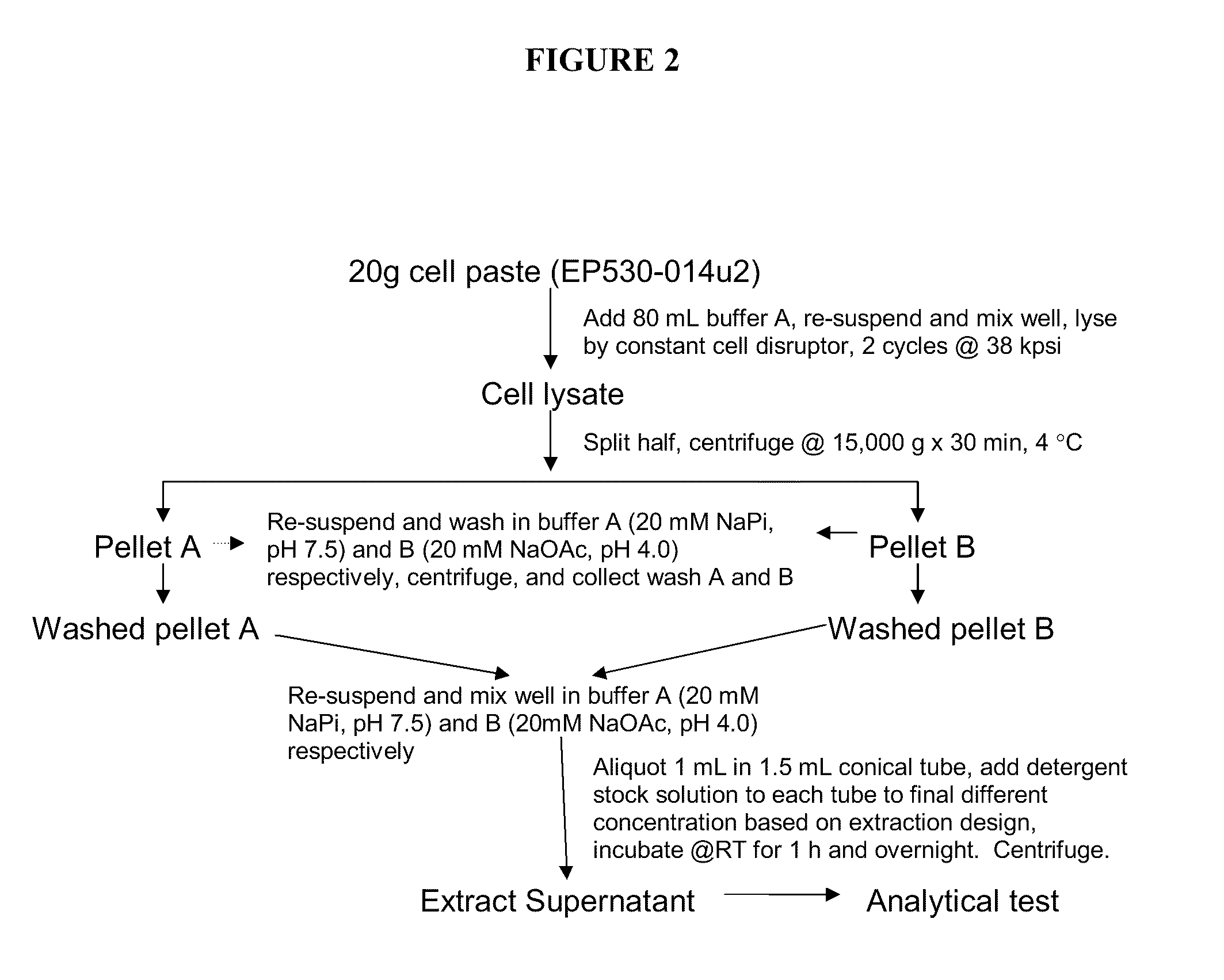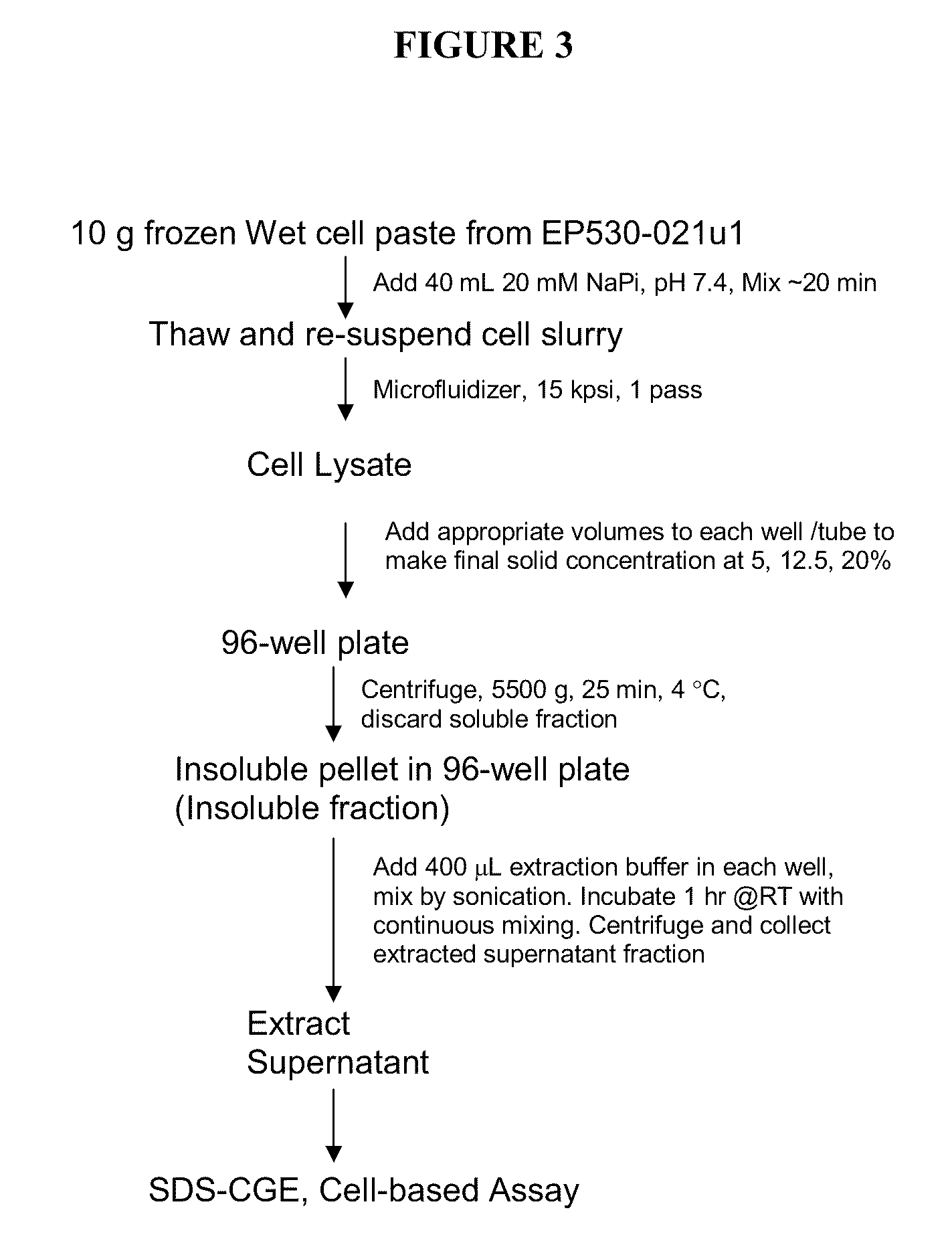Method for producing soluble recombinant interferon protein without denaturing
a technology of recombinant interferon and soluble recombinant protein, which is applied in the direction of instruments, peptides/protein ingredients, peptides, etc., can solve the problems of lowering process yield, adding cost and time to the production of recombinant protein, and affecting animal cell expression
- Summary
- Abstract
- Description
- Claims
- Application Information
AI Technical Summary
Benefits of technology
Problems solved by technology
Method used
Image
Examples
example 1
Production of rIFN-β from High Throughput Expression Samples
[0138]In the following experiment, IFN-β C17S expression strains were constructed, and the amount of IFN-β in the insoluble fraction obtained for each was quantitated. Based on the resulting data, certain strains were selected for use in optimizing the non-denaturing extraction process of the present invention.
[0139]Construction and Growth of IFN-β Expression Strains
[0140]The IFN-β 1b coding sequence was constructed using P. fluorescens preferred codons to encode for the human IFN-β amino acid sequence corresponding to the therapeutic Betaseron. FIG. 7 shows the amino acid (SEQ ID NO: 1) and DNA sequences (SEQ ID NO: 2) of the synthetic IFN-β (Betaseron) gene.
[0141]Plasmids were constructed which carry the codon-optimized IFN-β fused to nineteen P. fluorescens secretion leaders. The secretion leaders were included to target the protein to the periplasm where it may be recovered in the properly folded and active form. In add...
example 2
Extraction of IFN-β 1b from High Throughput Expression Material
[0152]IFN-β 1b was successfully extracted from insoluble fractions from HTP expression cultures, using extraction conditions comprising Zwittergent 3-14 detergent.
[0153]HTP expression plate cultures of Pseudomonas fluorescens strains PS530-001 overexpressing cytoplasmic IFN-β 1b and 530-220, overexpressing secreted IFN-β 1b (described in Example 1), were sonicated and centrifuged to obtain an insoluble fraction and a soluble fraction. The pellets were resuspended in extraction buffer 1×PBS, pH 7.4 or sodium acetate at pH 4.5. Each buffer was tested either with or without Zwittergent 3-14 detergent at 1% (w / v). Each of the four combinations of buffer and detergent was incubated for 1-2 hours at room temperature or overnight at 4° C. with shaking. After extraction, each sample was centrifuged for 20 minutes at 20,080×g at 4° C. to produce a second insoluble pellet fraction (extract pellet) and a second soluble supernatant ...
example 3
Optimization of Conditions for Extraction
[0154]Insoluble fractions from fermentation cultures were extracted under conditions comprising different detergents.
[0155]Frozen cell paste from a 1 L fermentation (grown at 32° C., pH 6.5, and induced using 0.2 mM IPTG at an OD575 of 100) of strain PS530-001, overexpressing recombinant IFN-β 1b, was resuspended in lysis buffer containing 20 mM sodium phosphate (JT Baker), pH 7.4 to a final solids concentration of 20% (w / v). The well-mixed cell slurry was lysed with two passes at 38 kpsi through a Constant cell disruptor (Constant Systems, Inc.). The lysate was split in half, and spun by centrifugation at 15,000×g for 30 minutes at 4° C. (Beckman Coulter, PN# J-20, XPF). The pellets (containing IFN-β and cell debris) were resuspended and each was washed in either Buffer A (20 mM sodium phosphate, pH 7.4) or Buffer B (20 mM sodium acetate, pH 4.0). Samples were spun by centrifugation under the same conditions described for the first spin, sup...
PUM
| Property | Measurement | Unit |
|---|---|---|
| concentration | aaaaa | aaaaa |
| volume | aaaaa | aaaaa |
| temperature | aaaaa | aaaaa |
Abstract
Description
Claims
Application Information
 Login to View More
Login to View More - R&D
- Intellectual Property
- Life Sciences
- Materials
- Tech Scout
- Unparalleled Data Quality
- Higher Quality Content
- 60% Fewer Hallucinations
Browse by: Latest US Patents, China's latest patents, Technical Efficacy Thesaurus, Application Domain, Technology Topic, Popular Technical Reports.
© 2025 PatSnap. All rights reserved.Legal|Privacy policy|Modern Slavery Act Transparency Statement|Sitemap|About US| Contact US: help@patsnap.com



